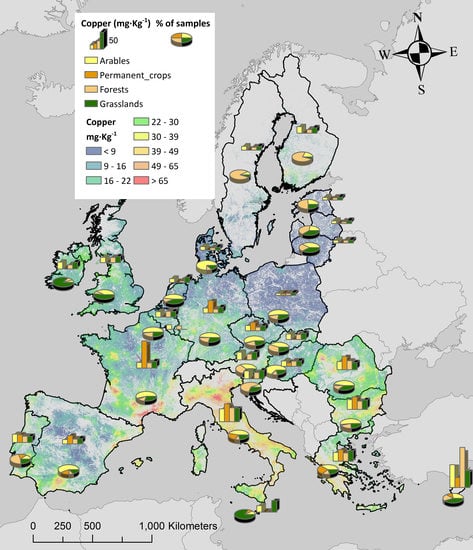Potential Sources of Anthropogenic Copper Inputs to European Agricultural Soils
Abstract
1. Introduction
2. Materials and Methods
2.1. Geodatabases
2.2. Statistical Analysis per Geographical Units and Land Cover Types
2.3. Modeling Copper Use in Relation to Fungicides Sales
2.4. Modeling the Copper Concentration in Relation to Distance from Mines
3. Results
3.1. Descriptive Statistics
3.2. Overview of Geographical Distribution of Copper by Administrative Unit
3.3. Copper Distribution in Forests and Grasslands
3.4. Copper Distribution in Croplands
3.5. Analysis of Copper in Vineyards
4. Discussion
4.1. Fungicide Sales as a Proxy for Copper Use
4.2. Copper Concentration and Liquid Manure in Agricultural Soils
4.3. Sewage Sludge and Copper
4.4. Influence of Mines on Copper Concentration
4.5. Other Anthropogenic Sources of Copper Accumulation
4.6. Recent Developments in Copper Use
5. Conclusions
Supplementary Materials
Author Contributions
Acknowledgments
Conflicts of Interest
References
- Alloway, B.J. Sources of heavy metals and metalloids in soils. In Heavy Metals in Soils; Springer: Dordrecht, The Netherlands, 2013; pp. 11–50. [Google Scholar]
- Borkow, G.; Gabbay, J. Copper, an ancient remedy returning to fight microbial, fungal and viral infections. Curr. Chem. Biol. 2009, 3, 272–278. [Google Scholar]
- Richardson, H.W. Handbook of Copper Compounds and Applications; CRC Press: New York, NY, USA, 1997; ISBN 1-4822-7746-8. [Google Scholar]
- Benns, B.G.; Gingras, B.A.; Bayley, C.H. Antifungal activity of some thiosemicarbazones and their copper complexes. Appl. Microbiol. 1960, 8, 353–356. [Google Scholar] [PubMed]
- Panagos, P.; Van Liedekerke, M.; Yigini, Y.; Montanarella, L. Contaminated sites in Europe: review of the current situation based on data collected through a European network. J. Environ. Public Health 2013, 2013. [Google Scholar] [CrossRef] [PubMed]
- Rajaganapathy, V.; Xavier, F.; Sreekumar, D.; Mandal, P.K. Heavy metal contamination in soil, water and fodder and their presence in livestock and products: a review. J. Environ. Sci. Technol. 2011, 4, 234–249. [Google Scholar]
- Komárek, M.; Čadková, E.; Chrastný, V.; Bordas, F.; Bollinger, J.-C. Contamination of vineyard soils with fungicides: A review of environmental and toxicological aspects. Environ. Int. 2010, 36, 138–151. [Google Scholar] [CrossRef] [PubMed]
- Ministry of Environment. Government Decree on the Assessment of Soil Contamination and Remediation Needs. Available online: https://www.ecolex.org/details/legislation/government-decree-on-the-assessment-of-soil-contamination-and-remediation-needs-no-214-of-2007-lex-faoc113198/ (accessed on 1 March 2017).
- Gawlik, B.M.; Bidoglio, G. Background Values in European Soils and Sewage Sludges; European Commission: Brussels, Belgium, 2006.
- Adriano, D.C. Trace Elements in Terrestrial Environments: Biogeochemistry, Bioavailability, and Risk of Metals; Springer-Verlag: New York, NY, USA, 2001; 866 p. [Google Scholar]
- Carlon, C. Derivation Methods of Soil Screening Values in Europe. A Review and Evaluation of National Procedures towards Harmonization; European Commission: Ispra, Italy, 2007; p. 306.
- Pietrzak, U.; McPhail, D.C. Copper accumulation, distribution and fractionation in vineyard soils of Victoria, Australia. Geoderma 2004, 122, 151–166. [Google Scholar] [CrossRef]
- Ballabio, C.; Panagos, P.; Lugato, E.; Huang, J.-H.; Orgiazzi, A.; Jones, A.; Fernández-Ugalde, O.; Borrelli, P.; Montanarella, L. Copper distribution in European topsoils: An assessment based on LUCAS soil survey. Sci. Total Environ. 2018, 636, 282–298. [Google Scholar] [CrossRef] [PubMed]
- Orgiazzi, A.; Ballabio, C.; Panagos, P.; Jones, A.; Fernández-Ugalde, O. LUCAS Soil, the largest expandable soil dataset for Europe: a review. Eur. J. Soil Sci. 2018, 69, 140–153. [Google Scholar] [CrossRef]
- Cristache, C.; Comero, S.; Locoro, G. Validation of A Horizontal Method for Trace Elements in Soil, Sludge and Biowaste; Publications Office of the European Union: Luxembourg, 2013. [Google Scholar]
- Tóth, G.; Hermann, T.; Da Silva, M.R.; Montanarella, L. Heavy metals in agricultural soils of the European Union with implications for food safety. Environ. Int. 2016, 88, 299–309. [Google Scholar] [CrossRef] [PubMed]
- Palmieri, A.; Martino, L.; Dominici, P.; Kasanko, M. Land cover and land use diversity indicators in LUCAS 2009 data. In Land Quality and Land Use Information; Tóth, G., Németh, T., Eds.; Publications Office of the European Union: Luxembourg, 2011; pp. 59–68. [Google Scholar]
- Panagos, P.; Ballabio, C.; Yigini, Y.; Dunbar, M.B. Estimating the soil organic carbon content for European NUTS2 regions based on LUCAS data collection. Sci. Total Environ. 2013, 442, 235–246. [Google Scholar] [CrossRef] [PubMed]
- EUROSTAT. Agri-Environmental Indicator-Consumption of Pesticides. Available online: http://ec.europa.eu/eurostat/statistics-explained/index.php/Agri-environmental_indicator_-_consumption_of_pesticides (accessed on 20 October 2017).
- COPERNICUS. CORINE Land Cover. Available online: https://land.copernicus.eu/pan-european/corine-land-cover/clc-2012 (accessed on 25 December 2017).
- Lopes, C.; Quental, L.; Oliveira, D.; Filipe, A.; Pereira, A. INSPIRE data harmonisation of mineral resources: Contribution of MINERALS4EU project. Mapping 2018, 187, 56–63. [Google Scholar]
- Zissimos, A.M.; Cohen, D.R.; Christoforou, I.C. Land use influences on soil geochemistry in Lefkosia (Nicosia) Cyprus. J. Geochem. Explor. 2017, 187, 6–20. [Google Scholar] [CrossRef]
- Huang, J.-H.; Ilgen, G.; Matzner, E. Fluxes and budgets of Cd, Zn, Cu, Cr and Ni in a remote forested catchment in Germany. Biogeochemistry 2011, 103, 59–70. [Google Scholar] [CrossRef]
- Toselli, M.; Schiatti, P.; Ara, D.; Bertacchini, A.; Quartieri, M. The accumulation of copper in soils of the Italian region Emilia-Romagna. Plant Soil Env. 2009, 55, 74–79. [Google Scholar] [CrossRef]
- Adrees, M.; Ali, S.; Rizwan, M.; Ibrahim, M.; Abbas, F.; Farid, M.; Zia-ur-Rehman, M.; Irshad, M.K.; Bharwana, S.A. The effect of excess copper on growth and physiology of important food crops: A review. Environ. Sci. Pollut. Res. 2015, 22, 8148–8162. [Google Scholar] [CrossRef] [PubMed]
- Romic, M.; Romic, D. Heavy metals distribution in agricultural topsoils in urban area. Environ. Geol. 2003, 43, 795–805. [Google Scholar] [CrossRef]
- Mackie, K.A.; Müller, T.; Kandeler, E. Remediation of copper in vineyards–a mini review. Environ. Pollut. 2012, 167, 16–26. [Google Scholar] [CrossRef] [PubMed]
- Provenzano, M.R.; El Bilali, H.; Simeone, V.; Baser, N.; Mondelli, D.; Cesari, G. Copper contents in grapes and wines from a Mediterranean organic vineyard. Food Chem. 2010, 122, 1338–1343. [Google Scholar] [CrossRef]
- Panagos, P.; Borrelli, P.; Meusburger, K.; Alewell, C.; Lugato, E.; Montanarella, L. Estimating the soil erosion cover-management factor at the European scale. Land Use Policy 2015, 48, 38–50. [Google Scholar] [CrossRef]
- EUROSTAT. The use of Plant Protection Products in the European Union. Available online: http://ec.europa.eu/eurostat/documents/3217494/5611788/KS-76-06-669-EN.PDF (accessed on 10 January 2018).
- Nicholson, F.A.; Chambers, B.J.; Williams, J.R.; Unwin, R.J. Heavy metal contents of livestock feeds and animal manures in England and Wales. Bioresour. Technol. 1999, 70, 23–31. [Google Scholar] [CrossRef]
- Xiong, X.; Yanxia, L.; Wei, L.; Chunye, L.; Wei, H.; Ming, Y. Copper content in animal manures and potential risk of soil copper pollution with animal manure use in agriculture. Resour. Conserv. Recycl. 2010, 54, 985–990. [Google Scholar] [CrossRef]
- EUROSTAT. Agricultural Production—Animals. 2018. Available online: http://ec.europa.eu/eurostat/statistics-explained/index.php/Agricultural_production_-_animals (accessed on 2 May 2018).
- Smolders, E.; Oorts, K.; Lombi, E.; Schoeters, I.; Ma, Y.; Zrna, S.; McLaughlin, M.J. The availability of copper in soils historically amended with sewage sludge, manure, and compost. J. Environ. Qual. 2012, 41, 506–514. [Google Scholar] [CrossRef] [PubMed]
- Amorosi, A.; Guermandi, M.; Marchi, N.; Sammartino, I. Fingerprinting sedimentary and soil units by their natural metal contents: A new approach to assess metal contamination. Sci. Total Environ. 2014, 500, 361–372. [Google Scholar] [CrossRef] [PubMed]
- Mantovi, P.; Bonazzi, G.; Maestri, E.; Marmiroli, N. Accumulation of copper and zinc from liquid manure in agricultural soils and crop plants. Plant Soil 2003, 250, 249–257. [Google Scholar] [CrossRef]
- Karvelas, M.; Katsoyiannis, A.; Samara, C. Occurrence and fate of heavy metals in the wastewater treatment process. Chemosphere 2003, 53, 1201–1210. [Google Scholar] [CrossRef]
- Boller, M.A.; Steiner, M. Diffuse emission and control of copper in urban surface runoff. Water Sci. Technol. 2002, 46, 173–181. [Google Scholar] [CrossRef] [PubMed]
- Fjällborg, B.; Dave, G. Toxicity of copper in sewage sludge. Environ. Int. 2003, 28, 761–769. [Google Scholar] [CrossRef]
- Roig, N.; Sierra, J.; Martí, E.; Nadal, M.; Schuhmacher, M.; Domingo, J.L. Long-term amendment of Spanish soils with sewage sludge: effects on soil functioning. Agric. Ecosyst. Environ. 2012, 158, 41–48. [Google Scholar] [CrossRef]
- Nicholson, F.A.; Smith, S.R.; Alloway, B.J.; Carlton-Smith, C.; Chambers, B.J. An inventory of heavy metals inputs to agricultural soils in England and Wales. Sci. Total Environ. 2003, 311, 205–219. [Google Scholar] [CrossRef]
- Eurostat Sewage Sludge. Sewage Sludge Production and Disposal. Available online: http://ec.europa.eu/eurostat/web/environment/water/main-tables (accessed on 20 April 2018).
- Kelessidis, A.; Stasinakis, A.S. Comparative study of the methods used for treatment and final disposal of sewage sludge in European countries. Waste Manag. 2012, 32, 1186–1195. [Google Scholar] [CrossRef] [PubMed]
- Milieu. Environmental, Economic and Social Impacts of the use of Sewage Sludge on Land. Available online: http://ec.europa.eu/environment/archives/waste/sludge/pdf/part_ii_report.pdf (accessed on 20 April 2018).
- Mininni, G.; Blanch, A.R.; Lucena, F.; Berselli, S. EU policy on sewage sludge utilization and perspectives on new approaches of sludge management. Environ. Sci. Pollut. Res. 2015, 22, 7361–7374. [Google Scholar] [CrossRef] [PubMed]
- Wilson, B.; Pyatt, F.B. Heavy metal dispersion, persistance, and bioccumulation around an ancient copper mine situated in Anglesey, UK. Ecotoxicol. Environ. Saf. 2007, 66, 224–231. [Google Scholar] [CrossRef] [PubMed]
- Chopin, E.I.B.; Alloway, B.J. Distribution and mobility of trace elements in soils and vegetation around the mining and smelting areas of Tharsis, Riotinto and Huelva, Iberian Pyrite Belt, SW Spain. Water. Air. Soil Pollut. 2007, 182, 245–261. [Google Scholar] [CrossRef]
- Davis, A.P.; Shokouhian, M.; Ni, S. Loading estimates of lead, copper, cadmium, and zinc in urban runoff from specific sources. Chemosphere 2001, 44, 997–1009. [Google Scholar] [CrossRef]
- Nriagu, J.O. A global assessment of natural sources of atmospheric trace metals. Nature 1989, 338, 47. [Google Scholar] [CrossRef]
- Creaser, C.S.; Wood, M.D.; Alcock, R.; Copplestone, D.; Crook, P.J.; Barraclough, D. UK Soil and Herbage Pollutant Survey: Environmental Concentrations of Polycyclic Aromatic Hydrocarbons in UK Soil and Herbage; Environment Agency: Bristol, UK, 2007.
- Oorts, K. Copper. In Heavy Metals in Soils; Springer: Dordrecht, The Netherlands, 2012; Volume 22, pp. 367–394. [Google Scholar]
- Alloway, B.J.; Zhang, P.; Mott, C.; Chambers, B.J.; Nicholson, F.A.; Smith, S.; Carlton-Smith, C.; Andrews, A.J. The Vulnerability of Soils to Pollution by Heavy Metals, Final Report for MAFF Contract SP0127; MAFF: London, UK, 2000.
- Copper Alliance European Copper Institute. Benefits of Copper. Available online: http://copperalliance.eu/industry (accessed on 1 May 2018).
- Pacyna, E.G.; Pacyna, J.M.; Fudala, J.; Strzelecka-Jastrzab, E.; Hlawiczka, S.; Panasiuk, D.; Nitter, S.; Pregger, T.; Pfeiffer, H.; Friedrich, R. Current and future emissions of selected heavy metals to the atmosphere from anthropogenic sources in Europe. Atmos. Environ. 2007, 41, 8557–8566. [Google Scholar] [CrossRef]
- Dierkes, C.; Geiger, W.F. Pollution retention capabilities of roadside soils. Water Sci. Technol. 1999, 39, 201–208. [Google Scholar] [CrossRef]
- Dafforn, K.A.; Lewis, J.A.; Johnston, E.L. Antifouling strategies: history and regulation, ecological impacts and mitigation. Mar. Pollut. Bull. 2011, 62, 453–465. [Google Scholar] [CrossRef] [PubMed]
- Dagostin, S.; Schärer, H.-J.; Pertot, I.; Tamm, L. Are there alternatives to copper for controlling grapevine downy mildew in organic viticulture? Crop Prot. 2011, 30, 776–788. [Google Scholar] [CrossRef]
- Kuehne, S.; Roßberg, D.; Röhrig, P.; von Mehring, F.; Weihrauch, F.; Kanthak, S.; Kienzle, J.; Patzwahl, W.; Reiners, E.; Gitzel, J. The Use of Copper Pesticides in Germany and the Search for Minimization and Replacement Strategies. Org. Farming 2017, 3, 66–75. [Google Scholar] [CrossRef]
- INRA. Peut-on se Passer du Cuivre en Protection des Cultures Biologigues? Available online: https://inra-dam-front-resources-cdn.brainsonic.com/ressources/afile/423215-51d65-resource-expertise-cuivre-en-ab-synthese-francais.pdf (accessed on 10 March 2018).
- Moolenaar, S.W. Heavy-Metal Balances, Part II: Management of Cadmium, Copper, Lead, and Zinc in European Agro-Ecosystems. J. Ind. Ecol. 1999, 3, 41–53. [Google Scholar] [CrossRef]
- EFSA Panel on Additives and Products or Substances used in Animal. Revision of the currently authorised maximum copper content in complete feed. EFSA J. 2016, 14, e04563. [Google Scholar]
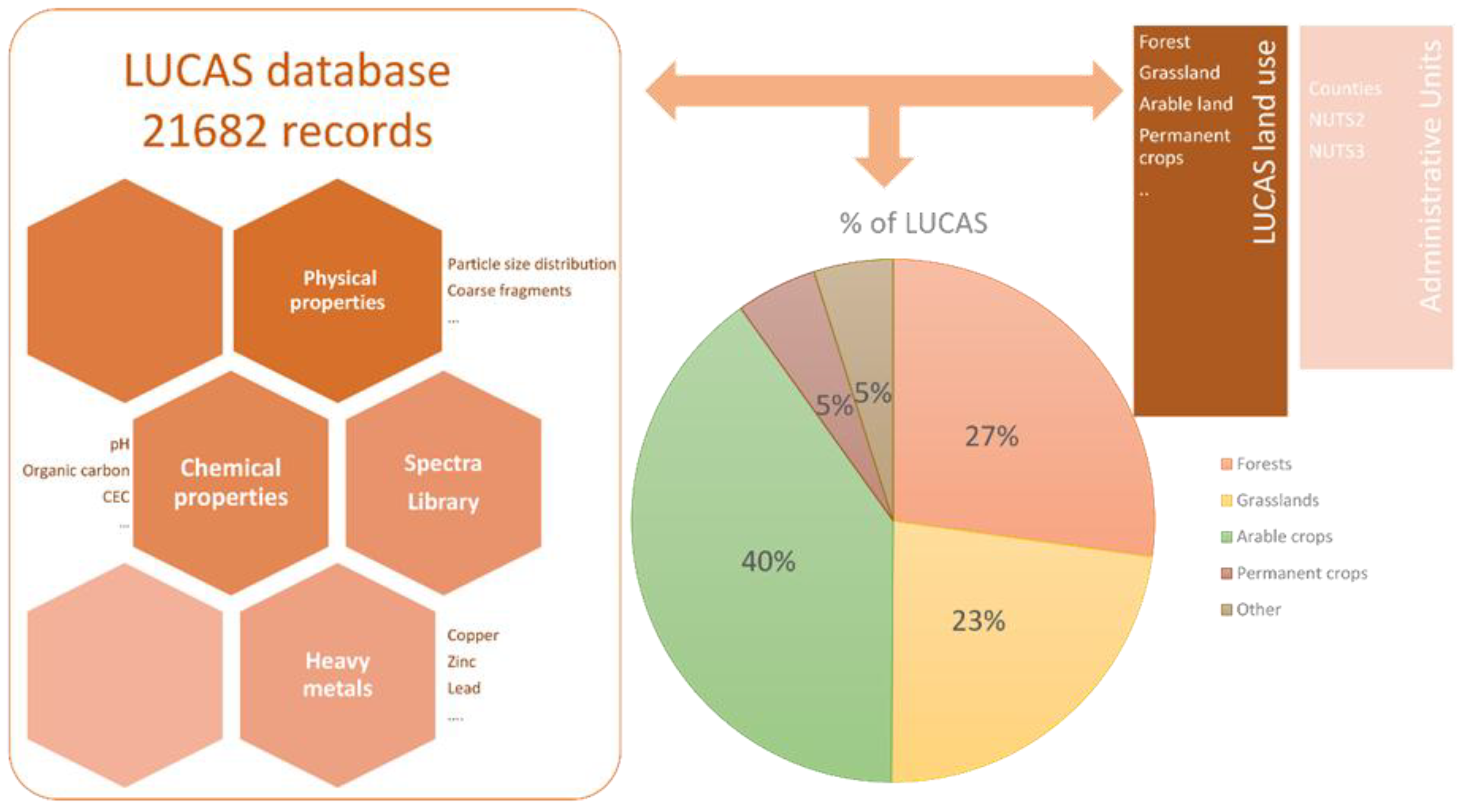
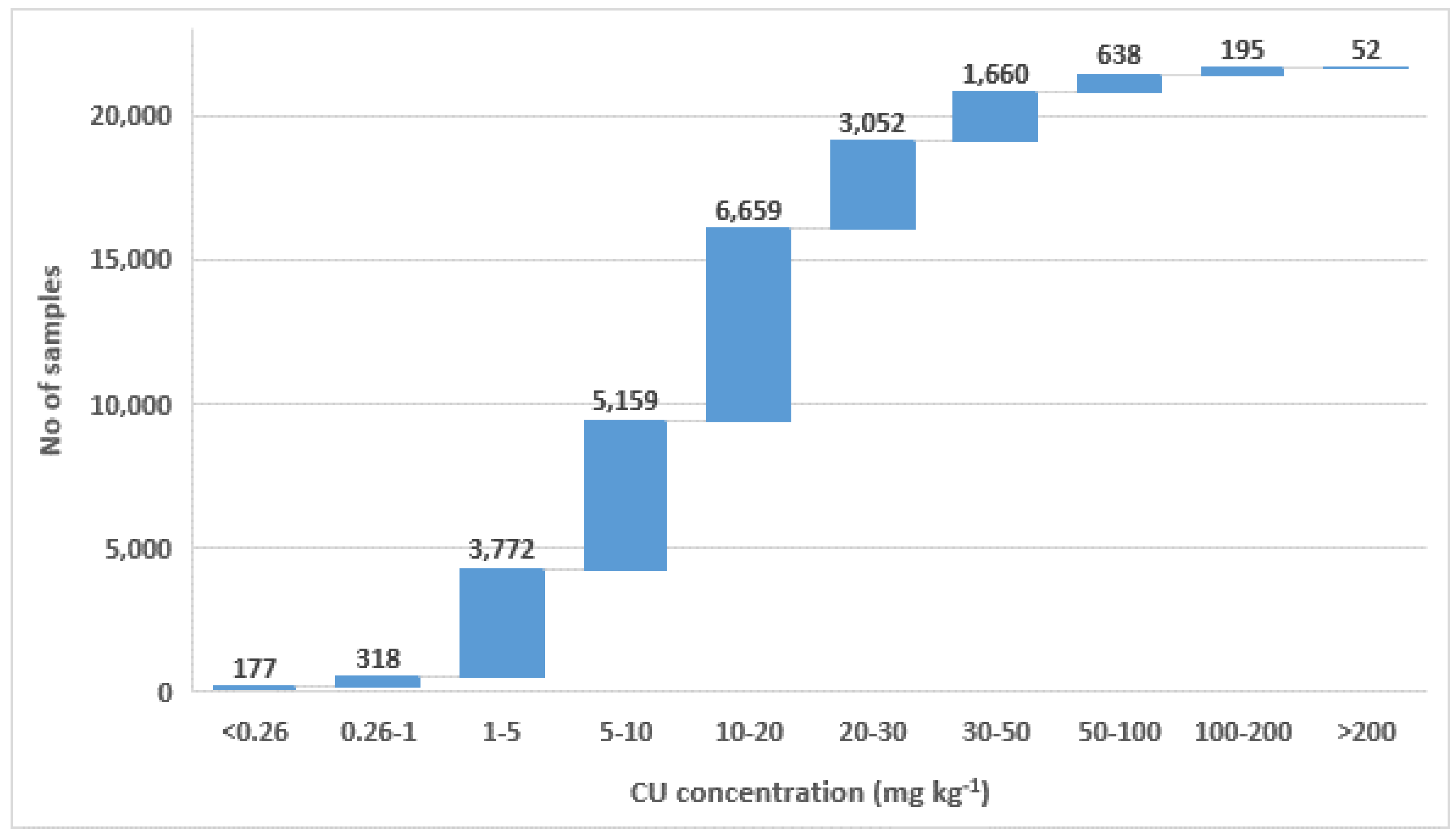
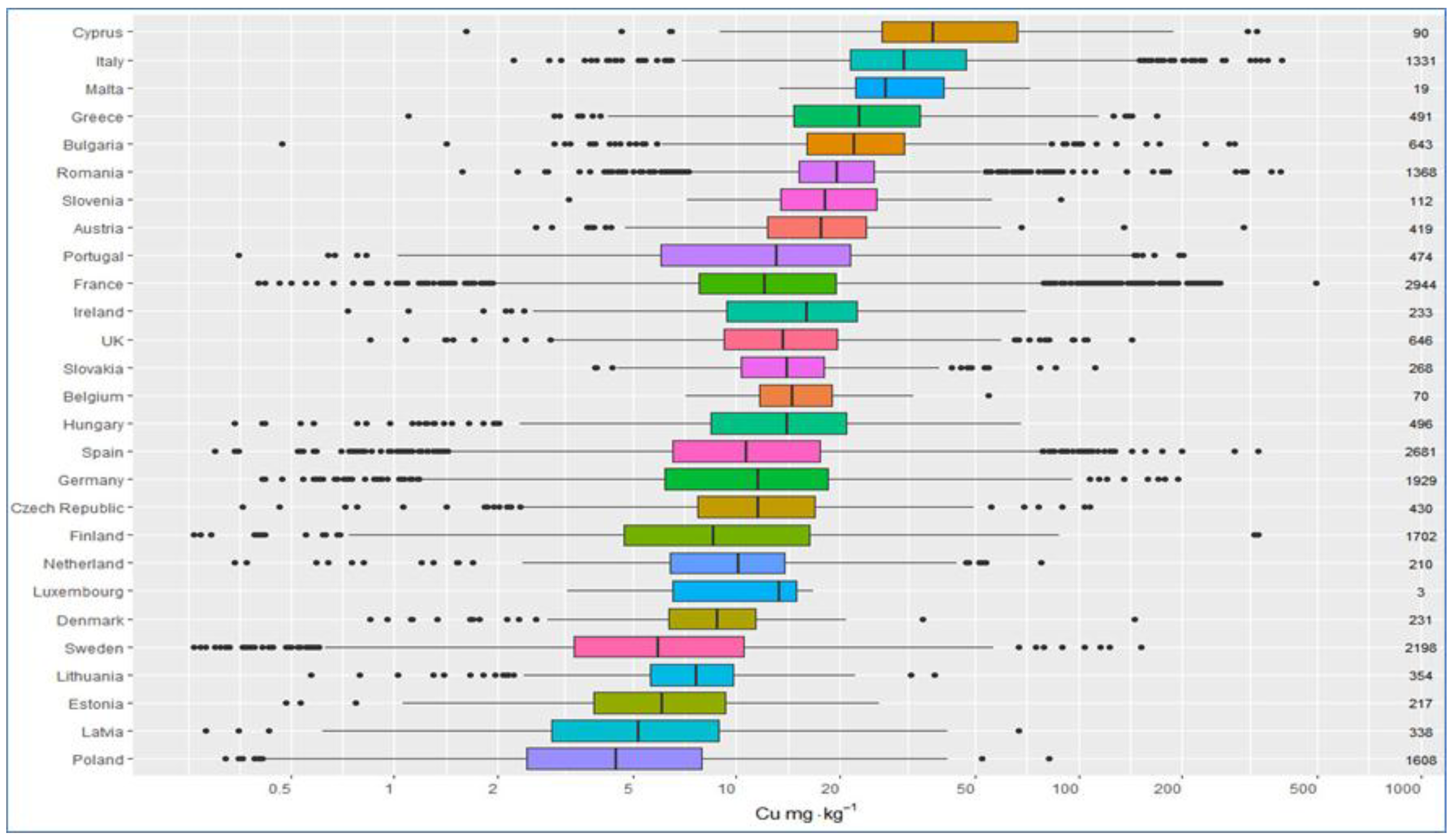
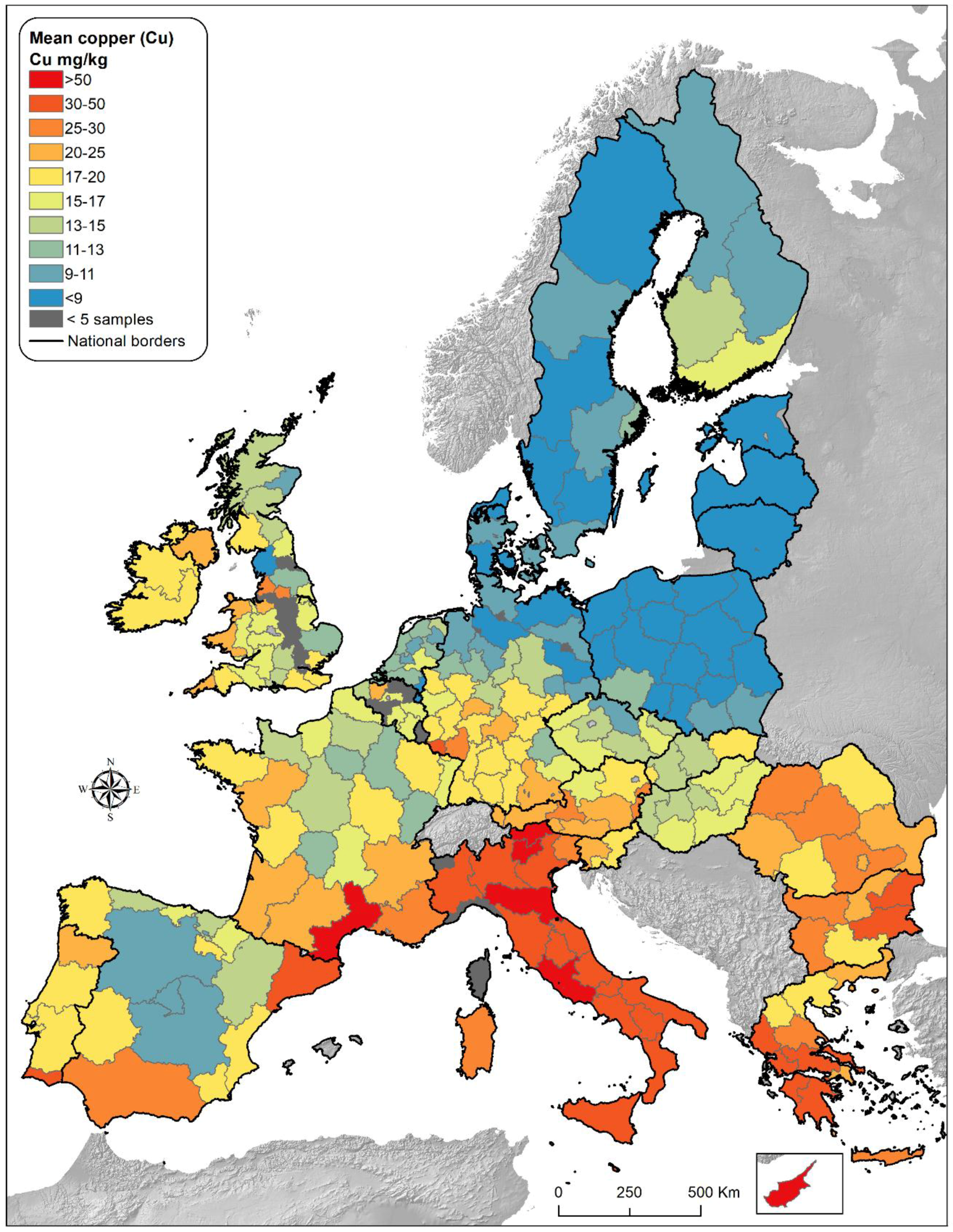
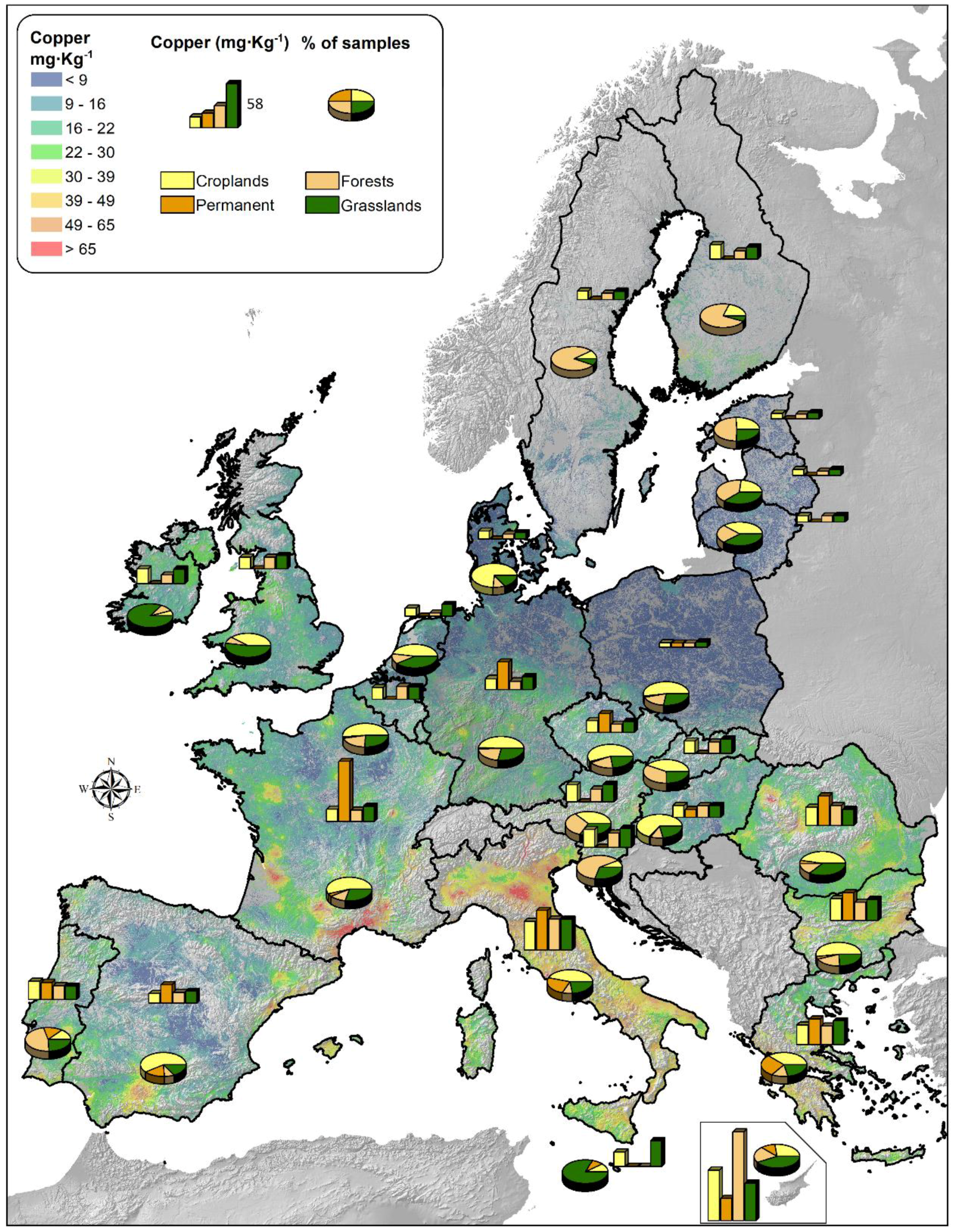
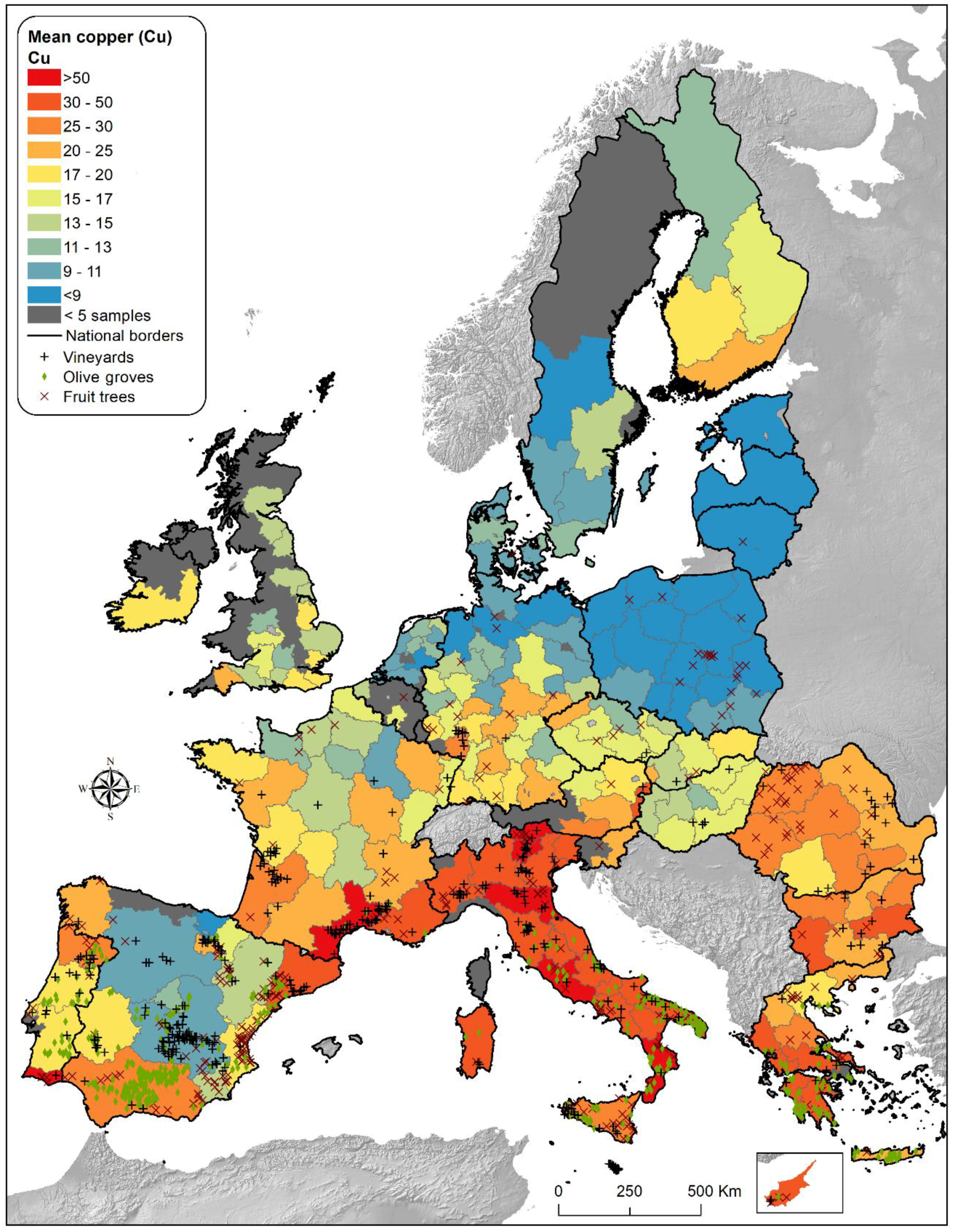
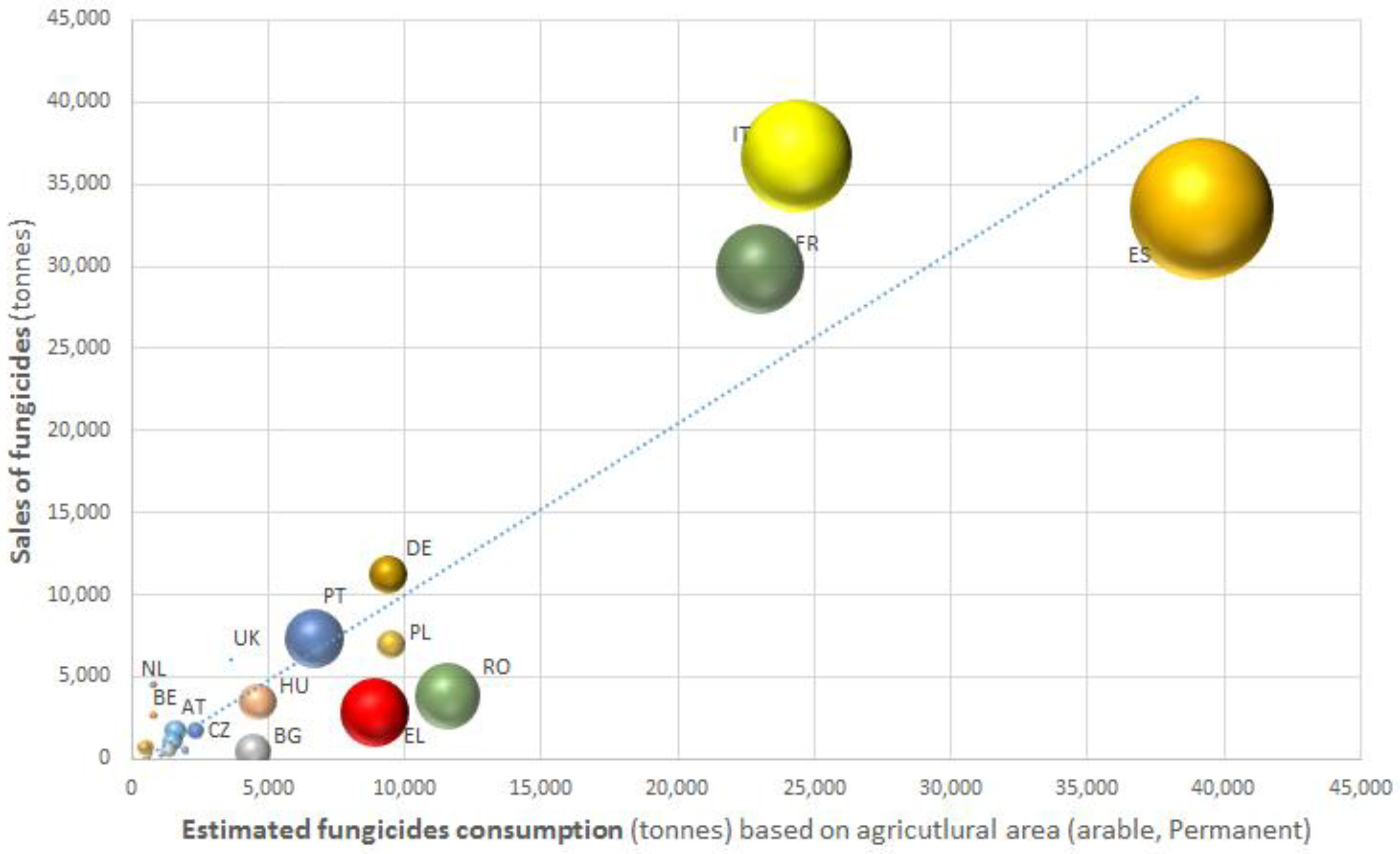
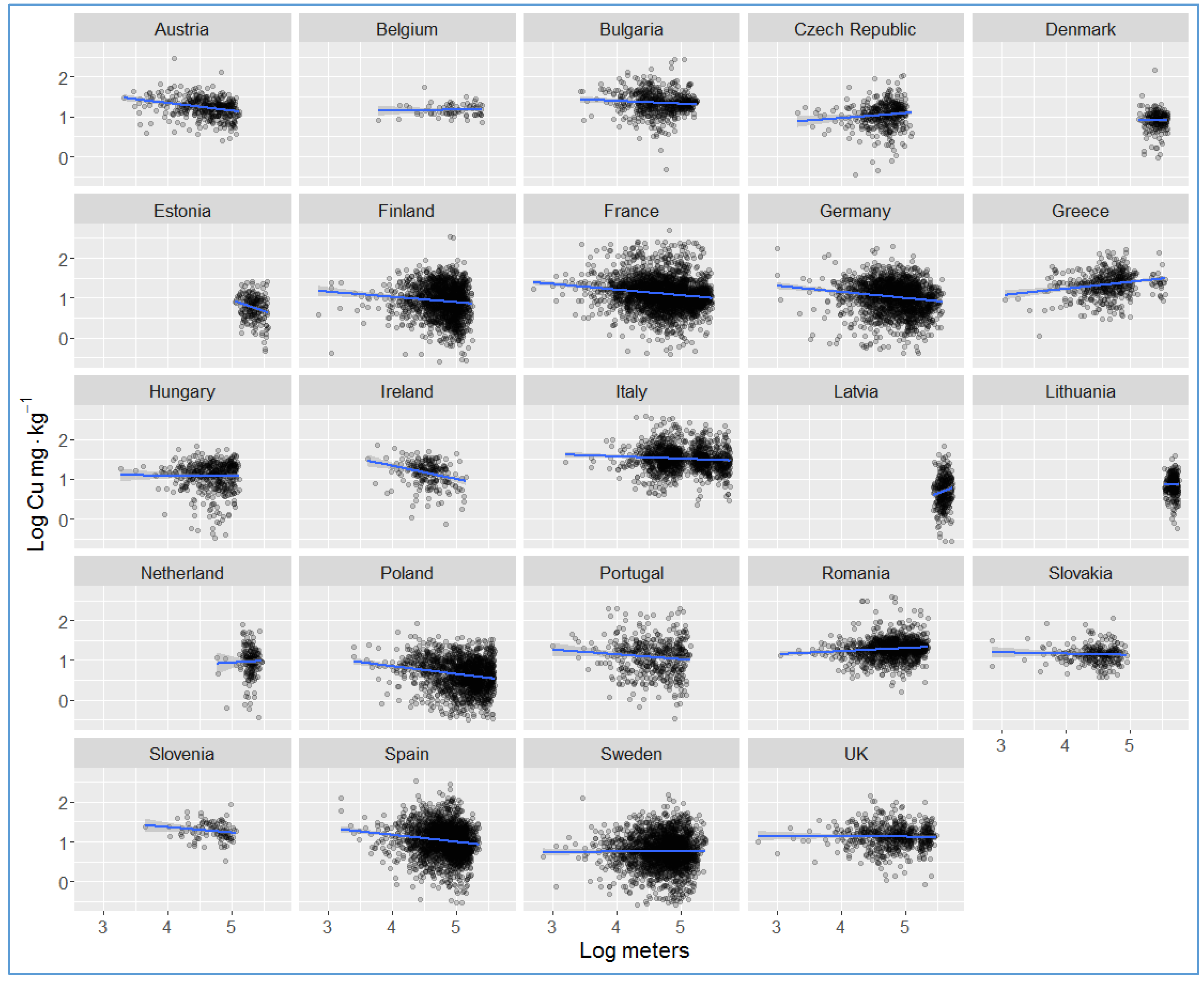
| Country | No of Samples | Mean Cu Concentration (mg kg−1) | No of Samples with Concentration >100 mg kg−1 |
|---|---|---|---|
| France | 65 | 91.29 | 27 |
| Italy | 86 | 71.90 | 17 |
| Romania | 16 | 64.87 | 3 |
| Germany | 11 | 54.69 | 1 |
| Bulgaria | 9 | 31.38 | - |
| Greece | 6 | 24.94 | - |
| Portugal | 18 | 23.76 | 1 |
| Spain | 120 | 16.50 | 1 |
| Hungary | 4 | 8.09 | - |
| Cyprus | 2 | 39.07 | - |
| Czech Republic | 2 | 36.29 | - |
| Austria | 1 | 20.24 | - |
| Malta | 1 | 36.10 | - |
| Total | 342 | 49.26 | 50 |
© 2018 by the authors. Licensee MDPI, Basel, Switzerland. This article is an open access article distributed under the terms and conditions of the Creative Commons Attribution (CC BY) license (http://creativecommons.org/licenses/by/4.0/).
Share and Cite
Panagos, P.; Ballabio, C.; Lugato, E.; Jones, A.; Borrelli, P.; Scarpa, S.; Orgiazzi, A.; Montanarella, L. Potential Sources of Anthropogenic Copper Inputs to European Agricultural Soils. Sustainability 2018, 10, 2380. https://doi.org/10.3390/su10072380
Panagos P, Ballabio C, Lugato E, Jones A, Borrelli P, Scarpa S, Orgiazzi A, Montanarella L. Potential Sources of Anthropogenic Copper Inputs to European Agricultural Soils. Sustainability. 2018; 10(7):2380. https://doi.org/10.3390/su10072380
Chicago/Turabian StylePanagos, Panos, Cristiano Ballabio, Emanuele Lugato, Arwyn Jones, Pasquale Borrelli, Simone Scarpa, Alberto Orgiazzi, and Luca Montanarella. 2018. "Potential Sources of Anthropogenic Copper Inputs to European Agricultural Soils" Sustainability 10, no. 7: 2380. https://doi.org/10.3390/su10072380
APA StylePanagos, P., Ballabio, C., Lugato, E., Jones, A., Borrelli, P., Scarpa, S., Orgiazzi, A., & Montanarella, L. (2018). Potential Sources of Anthropogenic Copper Inputs to European Agricultural Soils. Sustainability, 10(7), 2380. https://doi.org/10.3390/su10072380





